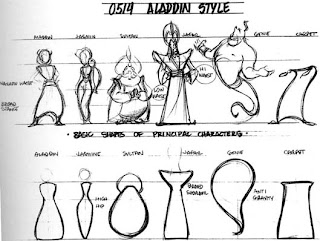Bill Peet The first thing you have to have is a set of characters that can carry you through the story once they're established. That's the most important part. It's like a train leaving the station without the passnegers: if you don't have the characters from the word go, you don't have the story really started. I'm very familiar with the characters before I get into the story. If I know them well, I can develop the story.
Jerry Rees[Brave Little Toaster] Once characgter was clearly defined, [radio is an entertainer no matter waht, the vacuum cleaner holds things inside, the lamps a bit dim]the scenes began to almost write themselves. You knew what they would or wouldn't say. THere's certainly room to develop and let that evolve, but you know what is in their nature and what isn't, and it builds.
Peter Schneider (VP Disney Pictures) I happen to think personality, character and story go hand in hand. it's like the train leaving the station with an engine, with the passengeres on it- it would be a very interesting ride but there's no control. I happen to think story is your control, from which characters and personalities must work as your framework to allow the entertainment, the jokes, the fun to happen. But story is the control that governs the speed, takes you up and down the hills and if you only have personality and characters, you don't ever get up your hills... You can't have a story without personality and character, and you can't have charaacters and personality without a very good story to hang the frame on.
Bill Peet: Yes, for animation you need strong, definite personalities, so that yo ucan have broad and explicit action, and there'll be no doubts about what your characters are thinking. in animation, we're not trying to duplicate live-action or create realism. We're trying to make it larger than life. We want exaggerated actions and attitudes. That's the fantasy of animation, more than special effects or all the wlid things they can do in STAR WARS. It's our larger than life personalities.
Canemaker: How do you make an audience feel something for these characters?
Rees: Well, you have to feel it first. That's the main thing. It's so easy to slip into formula approaches or cribbing something that has been done before in film... The thing is, those films {classic Disney films that influenced Rees et co} were a first-time experience for those story people and the animators invovled. And it was something they brought out of their own experience.
Rees talked about a moment of conflict in the Brave Little Toaster that they moved on from the Disney preference for pantomime>dialogue because having a well-written script scene allowed them to naturally fit in some needed exposition which allowed them to cut an unneccessary scene.
Rees: I have found a danger in having that collaborative thing be there all the time. {room full of story artists vs individual offices} My feeling of rhythm is that it's great to have collaboration to critique things. But then for a moment to really ring true, I feel it has to get down to an intimate exploration again. And one or two people is plenty for those moments, and then you expand to more people to have input on that. Just a personal thing, you know.
Animation staging is an important part of how you tell the story. {the equivalent of art of cinematography in live action}
There's a first impression you get, and changes that happen from that first impression can be very valuable. Changes that happen from your fifteenth or sixteenth impression just become reworking something because you are used to it. So you have to remember that your first impressions are more in tune with what the audience is going to feel.
Peet: I do agree with Walt Disney that to have to listen at great length ot an animated cartoon with voices coming on and on and on hurts the film, because it is an action medium. The fun of animatin is to see drawings in action...I still say that the charm of animation is the obvious appearance of it. It's a drawing come to life. And the living drawing is the charm of it. It always has been, no matter how elaborate you can make it. Animation stands alone.

I had had a story kicking around for a while. Or more accurately I had a cool setting and general idea, but no specific story. Then I started doodling out a character shape comparison sheet like this one from Aladin and BAM I immediately started getting an idea of who the characters where, how they would interact, and that was enough to start weaving the story. I think it helped that it was visual, I had tried to decide on personalities before, but that was using words, and I'm a visual thinker, asigning verbal personality traits felt so arbitrary, but matching personality traits to visuals felt totally natural and easy and intuitively right.

2 comments:
Great notes here man!
I love your blog.
jriggity
Cool blog!
Post a Comment